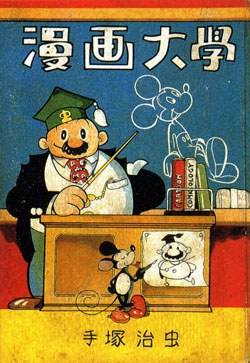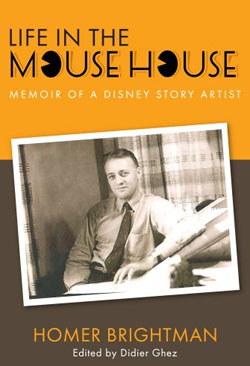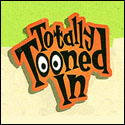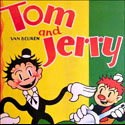
It’s been almost a year since I last wrote a rave review for one of David Gerstein’s books about Mickey Mouse – so I guess I’m about due for another round.
I just received a hot-off-the-press copy of Fantagraphics Books latest release from their Floyd Gottfredson Library, Mickey Mouse Outwits The Phantom Blot (publication date: July 5th, 2014). If you are serious about animation scholarship, Disney history… or just simply enjoy great cartooning and comic strips – you must buy these volumes. Buy one, buy them all – but do yourself a favor and check them out.
 Let’s remind ourselves why:
Let’s remind ourselves why:
1. First off, this is the first complete reprinting of a classic American comic strip, based on an iconic Internationally known cartoon character. The strip itself is both beautifully drawn and the stories – adventures, gags, dialogue – are text-book perfect examples of how it should be done. These books reprint every strip – including politically incorrect dailies that haven’t been seen in print for over 70 years.
2. The quality of the presentation is first rate – the strips are from master proof sheets previously locked up in the Disney vaults.
3. Each volume contains over 40 pages of “Bonus Material” – special historical pieces, articles, essays, rare images and art – which add to not only the enjoyment of the strips in each volume, but is fresh research that adds to our collective knowledge of Disney history. This is good, important stuff.
Now let’s look specifically at the latest volume:
The main content in the book is seven serialized stories (from February 1938 to April, 1940) plotted and pencilled by Gottfredson. The highlights among these for me are Mickey Mouse Meets Robinson Crusoe, Mickey Mouse Outwits the Phantom Blot and The Miracle Master.
In Robinson Crusoe, Mickey is an “actor” who’s latest picture is a castaway adventure in which we the reader get to enjoy as a story within the story – with Mickey, Crusoe and island native Friday captured by cannibals. Gerstein prefaces this section with rare posters from Mickey’s Man Friday (1935) and a model sheet from a proposed remake – of which this strip was a would-be tie-in. This is also the continuity in which Mickey’s eyes (per new studio model sheets) go from pie-cut ovals to the modern pupils, abruptly from one day to the next, without explanation (Gerstein includes the 1938 Freddy Moore model sheet that introduces the new look).

Cover of Japanese manga by Osamu Tezuka (1950)
The Miracle Master may be the most fun among the continuities here. Mickey buys an old lamp from a second hand shop – and as it turns out, there is a genie lurking within. Magical Mouseton mayhem ensues. As Thad Komorowski points out in his introduction, this story had Gottfredson introducing an element of fantasy into the otherwise “realistic” world he’s created for Mickey – as realistic as any world can be with talking animals. Though the ending may (or may not) be a cop-out, it allows the reader to reconsider the preceding.
Editors David Gerstein and Gary Groth augment the Mickey episodes with essays from guest contributors – including a thorough overview by scholar Thomas Andrae; a heartfelt “appreciation” by animator Craig McCracken; an excellent illustrated essay on Gottfredson’s influence on Osamu Tezuka (!) by Ryan Holmberg; and background material and rare images from international adaptations, film frame grabs, model sheets, Christmas Cards and much much more.
In a world gone digital, and the future of print in question, collections like this (and the whole series) make the case for physical books better than anything I can imagine. It’s a great big package of pure joy. My advice: pre-order it now!
Click embed below to take a sneak peek:
 While we’re on the subject of Disney, I’d like to recommend this book about and by Homer Brightman. Life In The Mouse House was written by Brightman in his retirement years as a reflection of his time employed by Walt Disney in the 1930s and 40s.
While we’re on the subject of Disney, I’d like to recommend this book about and by Homer Brightman. Life In The Mouse House was written by Brightman in his retirement years as a reflection of his time employed by Walt Disney in the 1930s and 40s.
The book is 127 pages, and 93 of those pages are by Brightman. The rest of the book contains his history beyond Disney (at Lantz, at Larry Harmon, later writing kiddie records, comics, books and Saturday morning cartoons); Alberto Becattini contributes an essay and filmography; Brightman’s daughters and grand daughter introduce the book.
I love books like this. First-hand accounts of what is was like to work at Disney’s (and occasionally with Walt himself) back in the golden age. Brightman was a gag writer and board artist. He talks of working on some of our favorite shorts and features, telling of the daily grind, the clashing personalities, the deals and decisions. He was apparently unafraid to tell Walt what he thought – and according to Brightman, Walt thought highly of his skills.
It’s all written in a highly entertaining style (though names were changed to protect the innocent – however, editor Didier Ghez translates the “cast” with a who’s-who at the front of the book). Recommended!


 Jerry Beck is a writer, animation producer, college professor and author of more than 15 books on animation history. He is a former studio exec with Nickelodeon Movies and Disney, and has written for The Hollywood Reporter and Variety. He has curated cartoons for DVD and Blu-ray compilations and has lent his expertise to dozens of bonus documentaries and audio commentaries on such. Beck is currently on the faculty of CalArts in Valencia, UCLA in Westwood and Woodbury University in Burbank – teaching animation history. More about Jerry Beck [
Jerry Beck is a writer, animation producer, college professor and author of more than 15 books on animation history. He is a former studio exec with Nickelodeon Movies and Disney, and has written for The Hollywood Reporter and Variety. He has curated cartoons for DVD and Blu-ray compilations and has lent his expertise to dozens of bonus documentaries and audio commentaries on such. Beck is currently on the faculty of CalArts in Valencia, UCLA in Westwood and Woodbury University in Burbank – teaching animation history. More about Jerry Beck [








I have a question I’d like to ask regarding Life In The Mouse House. Homer Brightman appears to have worked during the late 30’s and early 40’s on short subjects, mainly Donald Duck cartoons. Yet, as far as I can tell he doesn’t mention Jack King at all. Was the story department at Disney so far removed from the animation department that the two would have little interaction? I can’t imagine a memoir of a Warner’s story man that didn’t mention the animation directors he worked for.
Love that review copies go out months before contributor copies! Gotta love publishing.
With DVDs its even worse. Nine times out of ten, Warners would sent out contributors copies months after the DVD set was in release.
We are fortunate to have David G. Himself editing and assembling these books.
His basic philosophy seems to be to give the consumer a greater value for his dollar than the next cartoon reprint publisher.
Same as Disney Himself – give the consumer better animation, better artwork, better stories that the competition for the same price.
A GREAT business model.
Cant wait to own it
These books (as well as the Carl Barks series) are always a must-have on my list. Floyd Gottfredson is one of my favorite comics creators, and it is good to see his work being made available uncensored.